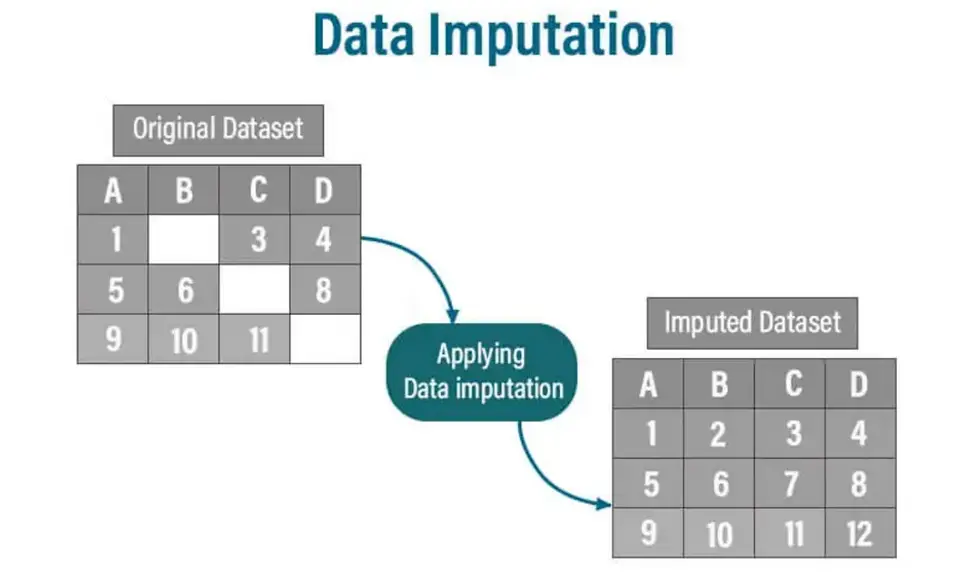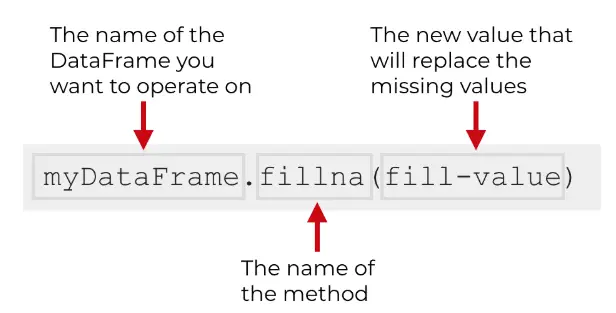Pandas fillna() for Data Imputation
Handling missing data is a crucial step in data analysis and machine learning. Missing values, stemming from various sources like data entry errors or inherent data limitations, can severely impact analysis accuracy and model reliability. Pandas, a powerful Python library, provides the fillna() method—a versatile tool for effective missing data imputation. This method allows replacing missing values with various strategies, ensuring data completeness for analysis.

Table of Contents
- What is Data Imputation?
- The Importance of Data Imputation
- Dataset Distortion
- Machine Learning Library Limitations
- Model Performance Impact
- Restoring Dataset Completeness
- Understanding Pandas
fillna()-
fillna()Syntax
-
- Data Imputation Techniques with
fillna()- Using Previous/Next Values
- Maximum/Minimum Value Imputation
- Mean Imputation
- Median Imputation
- Moving Average Imputation
- Rounded Mean Imputation
- Fixed Value Imputation
- Conclusion
- Frequently Asked Questions
What is Data Imputation?
Data imputation is the technique of filling in missing data points within a dataset. Missing data poses significant challenges for many analytical methods and machine learning algorithms that require complete datasets. Imputation addresses this by estimating and replacing missing values with plausible substitutes based on the available data.

Why is Data Imputation Important?
Several key reasons highlight the importance of data imputation:
- Dataset Distortion: Missing data can skew variable distributions, compromising data integrity. This can lead to inaccurate conclusions.
- Machine Learning Library Constraints: Many machine learning libraries assume complete datasets. Missing values can cause errors or prevent algorithm execution.
- Model Performance Impact: Missing data introduces bias, resulting in unreliable predictions and insights.
- Dataset Completeness: In situations with limited data, even small amounts of missing information can significantly affect the analysis. Imputation helps preserve all available information.
Understanding Pandas fillna()
The Pandas fillna() method is designed to replace NaN (Not a Number) values in DataFrames or Series. It offers various imputation strategies.
fillna() Syntax

Key parameters include value (the replacement value), method (e.g., 'ffill' for forward fill, 'bfill' for backward fill), axis, inplace, limit, and downcast.
Using fillna() for Different Imputation Techniques
Several imputation techniques can be implemented using fillna():
- Next or Previous Value: For sequential data, this method uses the nearest valid value.
- Maximum or Minimum Value: Useful when data is bounded.
- Mean Imputation: Replaces missing values with the column's mean. Sensitive to outliers.
- Median Imputation: Replaces missing values with the column's median. More robust to outliers than the mean.
- Moving Average Imputation: Uses the average of a window of surrounding values. Effective for time-series data.
- Rounded Mean Imputation: Replaces with the rounded mean, useful for maintaining data precision.
- Fixed Value Imputation: Replaces with a predetermined value (e.g., 0, 'Unknown').
(Code examples for each technique would be included here, mirroring the structure and content of the original text's code examples.)
Conclusion
Effective missing data handling is vital for reliable data analysis and machine learning. Pandas' fillna() method offers a powerful and flexible solution, providing a range of imputation strategies to suit different data types and contexts. Choosing the right method depends on the dataset's characteristics and the analysis goals.
Frequently Asked Questions
(The FAQs section would be retained, mirroring the original text's content.)
The above is the detailed content of Pandas fillna() for Data Imputation. For more information, please follow other related articles on the PHP Chinese website!

Hot AI Tools

Undresser.AI Undress
AI-powered app for creating realistic nude photos

AI Clothes Remover
Online AI tool for removing clothes from photos.

Undress AI Tool
Undress images for free

Clothoff.io
AI clothes remover

Video Face Swap
Swap faces in any video effortlessly with our completely free AI face swap tool!

Hot Article

Hot Tools

Notepad++7.3.1
Easy-to-use and free code editor

SublimeText3 Chinese version
Chinese version, very easy to use

Zend Studio 13.0.1
Powerful PHP integrated development environment

Dreamweaver CS6
Visual web development tools

SublimeText3 Mac version
God-level code editing software (SublimeText3)

Hot Topics
 1667
1667
 14
14
 1426
1426
 52
52
 1328
1328
 25
25
 1273
1273
 29
29
 1255
1255
 24
24
 10 Generative AI Coding Extensions in VS Code You Must Explore
Apr 13, 2025 am 01:14 AM
10 Generative AI Coding Extensions in VS Code You Must Explore
Apr 13, 2025 am 01:14 AM
Hey there, Coding ninja! What coding-related tasks do you have planned for the day? Before you dive further into this blog, I want you to think about all your coding-related woes—better list those down. Done? – Let’
 GPT-4o vs OpenAI o1: Is the New OpenAI Model Worth the Hype?
Apr 13, 2025 am 10:18 AM
GPT-4o vs OpenAI o1: Is the New OpenAI Model Worth the Hype?
Apr 13, 2025 am 10:18 AM
Introduction OpenAI has released its new model based on the much-anticipated “strawberry” architecture. This innovative model, known as o1, enhances reasoning capabilities, allowing it to think through problems mor
 Pixtral-12B: Mistral AI's First Multimodal Model - Analytics Vidhya
Apr 13, 2025 am 11:20 AM
Pixtral-12B: Mistral AI's First Multimodal Model - Analytics Vidhya
Apr 13, 2025 am 11:20 AM
Introduction Mistral has released its very first multimodal model, namely the Pixtral-12B-2409. This model is built upon Mistral’s 12 Billion parameter, Nemo 12B. What sets this model apart? It can now take both images and tex
 How to Add a Column in SQL? - Analytics Vidhya
Apr 17, 2025 am 11:43 AM
How to Add a Column in SQL? - Analytics Vidhya
Apr 17, 2025 am 11:43 AM
SQL's ALTER TABLE Statement: Dynamically Adding Columns to Your Database In data management, SQL's adaptability is crucial. Need to adjust your database structure on the fly? The ALTER TABLE statement is your solution. This guide details adding colu
 How to Build MultiModal AI Agents Using Agno Framework?
Apr 23, 2025 am 11:30 AM
How to Build MultiModal AI Agents Using Agno Framework?
Apr 23, 2025 am 11:30 AM
While working on Agentic AI, developers often find themselves navigating the trade-offs between speed, flexibility, and resource efficiency. I have been exploring the Agentic AI framework and came across Agno (earlier it was Phi-
 Beyond The Llama Drama: 4 New Benchmarks For Large Language Models
Apr 14, 2025 am 11:09 AM
Beyond The Llama Drama: 4 New Benchmarks For Large Language Models
Apr 14, 2025 am 11:09 AM
Troubled Benchmarks: A Llama Case Study In early April 2025, Meta unveiled its Llama 4 suite of models, boasting impressive performance metrics that positioned them favorably against competitors like GPT-4o and Claude 3.5 Sonnet. Central to the launc
 OpenAI Shifts Focus With GPT-4.1, Prioritizes Coding And Cost Efficiency
Apr 16, 2025 am 11:37 AM
OpenAI Shifts Focus With GPT-4.1, Prioritizes Coding And Cost Efficiency
Apr 16, 2025 am 11:37 AM
The release includes three distinct models, GPT-4.1, GPT-4.1 mini and GPT-4.1 nano, signaling a move toward task-specific optimizations within the large language model landscape. These models are not immediately replacing user-facing interfaces like
 How ADHD Games, Health Tools & AI Chatbots Are Transforming Global Health
Apr 14, 2025 am 11:27 AM
How ADHD Games, Health Tools & AI Chatbots Are Transforming Global Health
Apr 14, 2025 am 11:27 AM
Can a video game ease anxiety, build focus, or support a child with ADHD? As healthcare challenges surge globally — especially among youth — innovators are turning to an unlikely tool: video games. Now one of the world’s largest entertainment indus




